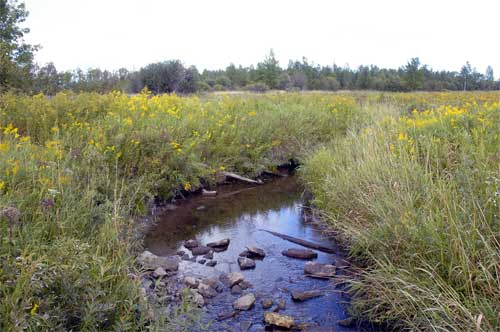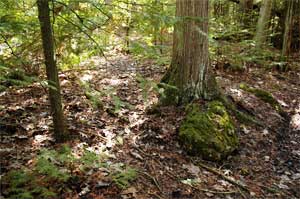Endangered Dragonfly Now Protected in Missouri and Michigan National Forests; New Habitat Added in Door County and other parts of of Wisconsin.
 The greenest celebration on Earth Day revolved around the Hine’s emerald dragonfly and the announcement that the critical habitat supporting America’s sole endangered dragonfly species would more than double in size. As a result of a settlement between environmental groups and the US Fish & Wildlife Service, the Midwestern insects will enjoy expanded protections in Michigan’s Hiawatha National Forest and the Mark Twain National Forest in Missouri. The new critical habitat rule ups the area of protection from 13,000 to 26,000 acres and adds some new areas in Wisconsin’s Door County.
The greenest celebration on Earth Day revolved around the Hine’s emerald dragonfly and the announcement that the critical habitat supporting America’s sole endangered dragonfly species would more than double in size. As a result of a settlement between environmental groups and the US Fish & Wildlife Service, the Midwestern insects will enjoy expanded protections in Michigan’s Hiawatha National Forest and the Mark Twain National Forest in Missouri. The new critical habitat rule ups the area of protection from 13,000 to 26,000 acres and adds some new areas in Wisconsin’s Door County.
“These gorgeous insects used to be found throughout the Midwest,” says Andrew Wetzler, director of the Wildlife Conservation Project for the Natural Resources Defense Council (NRDC). “We’ve lost so much of their habitat. And once the wetlands that support these dragonflies are gone, they are gone forever. Today’s decision ensures that we don’t lose any more.”
The new rule comes about in response to a suit filed by NRDC, Center for Biological Diversity, Northwoods Wilderness Recovery, Michigan Nature Association, Door County Environmental Council and the Habitat Education Center. The following are comments from some of the groups involved in the settlement:
“Thanks to the designation, Hine’s emerald dragonflies now have a chance to recover from the brink of extinction. Protecting habitat is the best way to bring back these spectacular insect predators” says John Buse, Senior Attorney with the Center for Biological Diversity.
“We are proud to have been a partner in this long effort to protect the beautiful Hines Emerald Dragonfly here in Wisconsin and throughout the habitat region,” says Door County Environmental Council executive director Jerry Viste. “This has been a long effort since the beginning of the awareness of this tiny creature in our area of Wisconsin and we appreciate the efforts that have been committed on its behalf. The Hines support here began more than 12 years ago with the discovery in remote wetland areas in northern Door and now has been expanded to include Kellner’s Fen and the Kayes Creek watershed. A very sincere thank you to the folks who carried this effort to completion.”
Hines Emerald Dragonfly Information
Size: The dragonfly is approximately 2.5 inches long with a 3.5-inch wingspan.
Appearance: The dragonfly has a dazzling metallic green body with shocking emerald-green eyes. It has yellow stripes on the sides of its body and a creamy-color to its wings. Males have a unique “clasper” at the end of their tails used to grab potential mates.
Flight: Dragonflies can fly at speeds up to 35 miles per hour. They can hover, fly backwards, change directions in mid-air, and are some of the most acrobatic fliers in the animal kingdom.
Habitat: These dragonflies rely on spring-fed marshes and meadows with high calcium carbonate levels in the water. Most of these wetland habitats have been drained for urban and industrial development.
Interesting facts:
- Most of these dragonflies’ life cycle is spent as a nymph: a dark, one-inch larva that has big teeth to capture prey, can move around using water jets, and lives in crawfish burrows. Nymphs are often described as looking like “hairballs with legs.”
- They live as nymphs for two to four years until they are ready to become adults. This process is much like a butterfly’s metamorphosis from a caterpillar. The nymphs shed their skin and an adult dragonfly emerges. Adults live for only two to six weeks.
- This species used to be far more widespread than it is today; it can no longer be found in Ohio, Alabama, or Indiana.
- Males and females have differently shaped sexual organs at the ends of their tails that allow copulation in flight.
Additional information on the Hine’s emerald dragonfly can be found at:
The Center for Biological Diversity is a nonprofit environmental organization dedicated to the protection of native species and their habitats through science, policy, and environmental law. The Center has more than 40,000 members worldwide, with offices in Tucson, San Francisco, Los Angeles, and Washington.
The Door County Environmental Council became a reality when several concerned citizens of the Fish Creek, Wisconsin area gathered to combine their concerns over the rapid resource destruction that was occurring in 1969. Since that time, nearly forty years ago we have been proudly engaged in battles, legal and otherwise, to preserve our vanishing resources.





